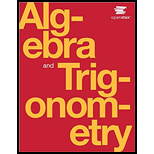
For the following exercises, use the model for the period of a pendulum, T, such that
46. If the acceleration due to gravity is
Want to see the full answer?
Check out a sample textbook solution
Chapter 2 Solutions
Algebra and Trigonometry
Additional Math Textbook Solutions
Elementary Statistics: Picturing the World (7th Edition)
Basic Business Statistics, Student Value Edition
University Calculus: Early Transcendentals (4th Edition)
Elementary Statistics (13th Edition)
- S SC0004 Chrome File 0- -o Edit View History Bookmarks Profiles Tab Window Help www-awu.aleks.com/alekscgi/x/Isl.exe/1o_u-IgNsIkas NW8D8A9... Quiz 2 Unit Circle Question 3 of 5 (1 point) | Question Attempt: 1 of 1 1 2 3 4 = 5 Answer the following. (a) For each function below, indicate whether it is odd, even, or neither. f(x) = secx Odd Even Neither g(x) = cosx Odd Even Neither Απ (b) sec (Choose one) 11 (c) cos(-59°) = (Choose one) Continue O 202 ☑ G LT + Time Remaining: 17:04 Taylen Español Submit Assignment © 2025 McGraw Hill LLC. All Rights Reserved. Terms of Use | Privacy Center | Accessibility only Horo 324 1 JAN O O O 14 άtvarrow_forwardS Chrome File Edit View History Bookmarks Profiles Tab Window Help 0- -o www-awu.aleks.com/alekscgi/x/Isl.exe/1o_u-IgNsIkasNW8D8A9... Quiz 2 Unit Circle LT + Time Remaining: 22:04 Taylen Question 5 of 5 (1 point) | Question Attempt: 1 of 1 1 2 3 4 5 LO Español Suppose that is an angle in standard position whose terminal side intersects the unit circle at Find the exact values of cote, cose, and csc 0. 12 5 (몸-음) 13 13 SC0004 cote cose = ☐ = csc0 = II ☐ ☐ 202 O|O ☑ Submit Assignment © 2025 McGraw Hill LLC. All Rights Reserved. Terms of Use | Privacy Center | Accessibility only Horo 324 1 JAN O O O 14 άtvarrow_forwardplete the parts below. ) Two unit circles are shown. Sketch the requested angles in standard position. Sketch the angle 11π 6 11π radians. Sketch the angle radians. 6 Español (1, 0) (1, 0) Drag to show the angle. Drag to show the angle. 스 Х ) Find the following. Use exact values and not decimal approximations. 11π sin ☐ 6 Continue SC0004 O 스 Х G Submit Assignment © 2025 McGraw Hill LLC. All Rights Reserved. Terms of Use | Privacy Center | Accessibility Silve Sobole 324 JAN O O O 14 ŕtvarrow_forward
- Let θ = - 11π/4Part A: What is a coterminal angle of θ such that 0 ≤ θ ≤ 2π?Part B: What are the exact values of all six trigonometric functions evaluated at θ?arrow_forwardTriangle ΔABC has side lengths of a = 15, b equals 15 times square root of 3 and c = 30 inches. Part A: Determine the measure of angle m∠B. Part B: Show how to use the unit circle to find tan B. Part C: Calculate the area of ΔABC.arrow_forwardPart A: Given sinθ = square root of 3/2, determine three possible angles θ on the domain [0,∞).Part B: Given θ = 675°, convert the value of θ to radians and find sec θ.arrow_forward
- 1.evaluate using gamma function Find the factorial of a.3*7/2! b.(13/2)! * 6! * 2/3 Please don't use artificial intelligencearrow_forwarda. A company is offering a job with a salary of $35,000 for the first year and a 3% raise each year after that. If the 3% raise continues every year, find the amount of money you would earn in a 40-year career.arrow_forward© © Q Tue 7 Jan 10:12 pm myopenmath.com/assess2/?cid=253523&aid=17... ookmarks 吕 Student Account... 8 Home | Participant... 001st Meeting with y... E F D c G B H I A J P K L N M Identify the special angles above. Give your answers in degrees. A: 0 B: 30 C: 45 D: 60 E: 90 > १ F: 120 0 G: H: 1: 180 0 J: K: L: 240 0 Next- M: 270 0 0: ZÖÄ N: 300 0 Aa zoom P: Question Help: Message instructor MacBook Air Ο O Σ >> | All Bookmarksarrow_forward
- Make M the subject: P=2R(M/√M-R)arrow_forwardDirection: This is about Maritime course, Do a total of 6 (six) of this. Strictly write this only in bond paper. COMPLETE TOPIC AND INSTRUCTION IS ALREADY PROVIDED IN THE PICTURE. NOTE: strictly use nautical almanac. This is about maritime navigation.arrow_forwardFind the points of intersections of the function f(x) and its derivative. f(x)=(2x-3)√xarrow_forward
 Linear Algebra: A Modern IntroductionAlgebraISBN:9781285463247Author:David PoolePublisher:Cengage Learning
Linear Algebra: A Modern IntroductionAlgebraISBN:9781285463247Author:David PoolePublisher:Cengage Learning
 Trigonometry (MindTap Course List)TrigonometryISBN:9781305652224Author:Charles P. McKeague, Mark D. TurnerPublisher:Cengage Learning
Trigonometry (MindTap Course List)TrigonometryISBN:9781305652224Author:Charles P. McKeague, Mark D. TurnerPublisher:Cengage Learning Mathematics For Machine TechnologyAdvanced MathISBN:9781337798310Author:Peterson, John.Publisher:Cengage Learning,
Mathematics For Machine TechnologyAdvanced MathISBN:9781337798310Author:Peterson, John.Publisher:Cengage Learning,



